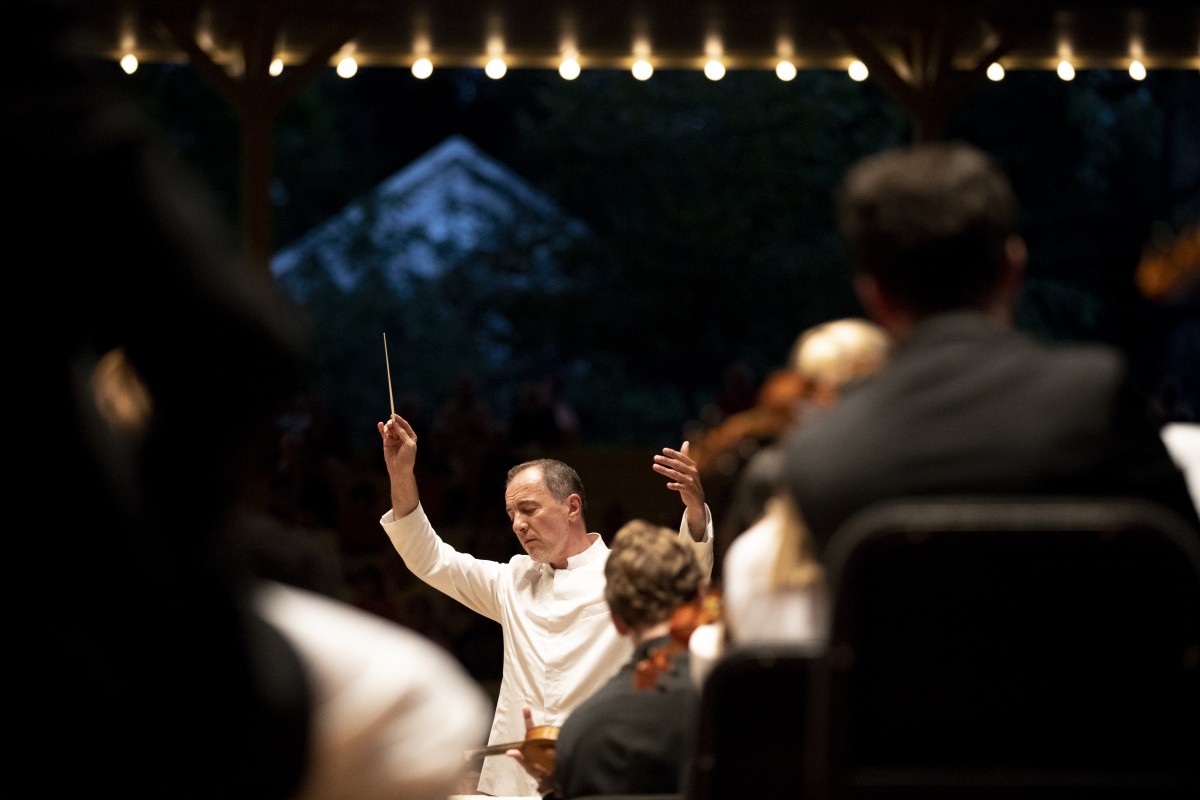The programming for Chautauqua’s week devoted to “Russia and the West” has attracted unusually large and interested audiences just as the international stage could not have made the topic more timely with the summit in Helsinki last Monday between President Donald Trump and President Vladimir Putin. The contribution of the Chautauqua Symphony Orchestra on Wednesday night, July 18, also proved apt, although this could hardly have been anticipated when it was devised months ago.
In a concert that combined the forces of the CSO and the Music School Festival Orchestra, Rossen Milanov magnificently conducted a single work: Dmitri Shostakovich’s seventh symphony, composed in the latter half of 1941. By the following summer, this was the most important piece of contemporary classical music in the world. Shostakovich wrote it under harrowing circumstances in his hometown of Leningrad (now again St. Petersburg) during the Germans’ 900-day siege of the city.
Both the composer and his imposing symphony, known as the “Leningrad” and dedicated to the city, became symbols of Russian resistance to the Nazis. The work also proved to be an effective aesthetic asset for boosting the American and Russian alliance. Leading conductors of the day, including Arturo Toscanini, Leopold Stokowski and Serge Koussevitzky, vied for who would get the honor of conducting the American premiere in the summer of 1942, a few months after its Soviet unveiling and a few weeks after the first Western performance in London.
The drama unfolded as a microfilm of the score wended a circuitous route to New York City. Toscanini’s broadcast premiere with the NBC Symphony on Sunday afternoon, July 10, reached millions of homes and landed Shostakovich on the cover of Time.
Koussevitzky soon performed the work at Tanglewood, and in short order it was taken up by orchestras across the country. This all happened too quickly for the work to be performed here at Chautauqua that summer, although the composer’s magnificent fifth symphony was for the first time. (The Daily critic called it a “masterpiece … truly one of the greatest compositions of recent years.”)
Fast forward 76 years to our current moment of unusual tension after the Russian interference in the 2016 election. What an extraordinary opportunity to hear the “Leningrad” symphony, written at a time of mutually advantageous cooperation between America and Russia, performed by musicians ranging in age from their teens to 70s.
I am not certain when Chautauqua first presented a joint CSO/MSFO concert, but as I remember, it was in 1976 with Sergiu Comissiona conducting Mahler’s first symphony. At that time, a special extension had to be built to fit all the musicians on stage, but with the mechanics of the reconstructed Amphitheater, such stage magic can now happen with the push of a button. How wonderful it is to witness 153 musicians perform together, with students sitting alongside their teachers. Such multigenerational performances have been highlights of past seasons, and I hope will become annual events.
On Wednesday, Chautauquans may have been initially baffled to encounter an empty stage, but Deborah Sunya Moore, vice president of performing and visual arts, soon explained the reason: The evening would begin with an excerpt from a 1997 documentary by Larry Weinstein, “The War Symphonies: Shostakovich against Stalin.” The 15-minute section concerning the “Leningrad” symphony includes grim archival footage of the horrific conditions in the city, testimonials from everyday Russians who survived the siege, interviews with Shostakovich’s family and colleagues and clips of a performance conducted by Valery Gergiev.
The full film, although expertly crafted and edited, proved problematic for some scholars because of its revisionist stance, reflected in the title. What was screened on Wednesday, July 18, nonetheless effectively, if disturbingly, set up the circumstances under which the “Leningrad” symphony was composed and first performed. I wish the selection had ended some 30 seconds earlier, as the final soundbite attributed to Shostakovich — that this was the Leningrad “that Stalin destroyed and Hitler merely finished off” — comes from the fraudulently presented “memoirs” of the composer as related to Solomon Volkov and most likely are not his own words.
After the film, the musicians came on stage, tuned, and, as Milanov emerged, the fire siren began to sound in the distance, slightly delaying the start of the music. Such things happen not infrequently at Chautauqua, but in the instance it proved almost an uncanny interference of the real — the documentary had related how air-raid sirens sounded outside of Philharmonic Hall during the Leningrad premiere of the symphony.
After the extraordinary attention the seventh symphony received during the second World War, the piece quickly disappeared for many decades in the West. Performances are still relatively infrequent today, due partly to its size and length, although there has been a notable revival in the last decade. Shostakovich went on to write eight more symphonies, with the first, fifth, and 10th most firmly in the repertory. His symphonies emerged as the most important contribution to the genre since Gustav Mahler (whom he idolized) and raise fascinating questions about meaning in music.
Although Shostakovich withdrew the titles he initially devised for each of the symphony’s four movements (“War,” “Memories,” “The Expanses of our Native Country” and “Victory”), the circumstances of its genesis and premiere were trumpeted before each performance. Lengthy program notes informed wartime audiences in America about the career of the 35-year-old Russian and his intentions in the work.
The international attention the “Leningrad” received in 1942 was possibly without precedent in the history of music, although this interest was not for purely musical reasons. The symphony merged art and politics in the most vivid ways, and it is fascinating how more than 75 years later, the work continues to raise important aesthetic and political issues. Screening part of the documentary recaptured something of the historical context surrounding the work.
The CSO/MSFO performance was terrific, the most satisfying I have heard of this symphony live in concert. Part of that effectiveness came from the sheer mass of sound. Shostakovich wanted a lot of players, strings in particular. The score calls for 10 to 14 cellos and eight to 12 basses, and Chautauquans got even more: 18 and 14, respectively. (The first performance in Leningrad, with a decimated orchestra, entirely omitted some crucial instruments.) The level of playing — youthful enthusiasm (what an experience for young musicians to participate in an event like this) mixed with distinguished professionalism — was extremely impressive, occasional flubs from the brass notwithstanding.
The first movement centrally features what came to be called the “invasion” episode. After about seven minutes, piccolo and solo violin melodies trail off, revealing the subdued presence of a snare drum. A new theme plucked and tapped by the strings suggests an approaching march. The theme is deceptively cheerful but also uncannily ominous. The tune bears a close resemblance to an aria from Franz Lehár’s The Merry Widow and was soon parodied by Béla Bartók in his Concerto for Orchestra, which the CSO performed last week. During the next 10 minutes, the theme is repeated, growing gradually in instrumentation and dynamics, much as Maurice Ravel did in “Bolero.” Shostakovich had already predicted how some would respond: “Idle critics will surely rebuke me for imitating Bolero. Well, let them; that is how I hear the war.”
Milanov effectively paced his invasion and later pulled out all the stops for the brilliant coda to the last movement, producing one of the most compelling orchestral moments I have ever experienced in the Amphitheater. Although Wednesday was a long, intermissionless evening — ending exactly at 10 p.m. — almost all of the large audience remained riveted, and at the end, everyone jumped to their feet.
Shostakovich’s “Leningrad” symphony was the perfect piece to perform at this fraught moment in history and memorably contributed to the theme of the week, doing what Chautauqua is uniquely positioned to do by offering an experience where history, ideas and the arts intersect, complement, and enrich one another.
Christopher H. Gibbs is James H. Ottaway Jr. Professor of Music at Bard College, Co-Artistic Director of the Bard Music Festival, and Executive Editor of The Musical Quarterly. Among his books are The Life of Schubert and The Oxford History of Western Music, College Edition, co-authored with Richard Taruskin. Since 2000, he has written the program notes for the Philadelphia Orchestra.








